Skiing & Snowboarding in Zermatt | Complete Resort Guide
As well as excellent skiing, incredible restaurants and easy access to Italy, Zermatt village has a magical feel in the winter months. With famous après ski and a tonne of additional activities, there’s plenty to do for the non-skiers, too.
In this post, we’ll share everything you need to know for the perfect Zermatt ski or snowboard trip. From maps and lift info to accommodation tips and insider advice, this guide is designed to help make your visit as smooth and enjoyable as possible.

Key Takeaways
✦ Zermatt has 360km of beginner to expert pistes, mainly catering to intermediate skiers and snowboarders.
✦ The après ski scene, culinary offerings and winter events, make Zermatt an excellent destination for groups, foodies, couples and music lovers.
✦ Families with young children can enjoy free skiing for children up to 9 yrs old. Many hotels also offer family friendly deals on beds and meals for children.
Discover Zermatt contains affiliate links, if you make a purchase using one of these links, we may receive compensation at no extra cost to you. Read our disclaimer for more information.
Skiing & Snowboarding in Zermatt
Zermatt is a great place to ski or board, no matter your skill level. This resort’s uniqueness is that you can ski or snowboard 365 days a year. In the winter, there are three main ski areas and links to two Italian ski resorts, which can all be accessed on one international ski pass.
The Matterhorn Ski Paradise is the highest ski area in Switzerland, sitting at 3,883m on the border of Italy. Zermatt and Breuil-Cervinia share this area. The combined amount of skiable area is 360 km of slopes. That is A LOT of mountain to explore!
One of my favourite things about Zermatt during the winter is being able to say, “Shall we ski to Italy for lunch?”

Things to Know Before You Go
There are no green slopes in Zermatt.
74 km Blue Slopes – Beginner (easy)
227 km Red Slopes – Intermediate (medium)
20 km Black Slopes – Expert (hard)
36 km Yellow Slopes – Marked Off-Piste (expert only)
The longest ski run from Klein Matterhorn to Valtournenche is 22 km
The second-longest ski run from Klein Matterhorn to Zermatt is 16 km
Zermatt village sits at 1620 m
Zermatt can make artificial snow on 75% of the pistes, a great advantage during a low-snow year.
While some lifts operate from 8:30 am to 5:00 pm, others close earlier. Be aware of the times of your connection and make sure not to get stuck in Italy. That’s a pricey taxi back to Zermatt, not to mention a 4-hour drive.
Zermatt has some of the best mountain restaurants in the world, many accessible without skiing. This is ideal for a mixed group of skiers and non-skiers to meet for lunch.
Zermatt is a car-free village; access is by train, transfer, or helicopter. The nearest place to park is in Täsch.
Music lovers have plenty of choice for amazing après ski spots, live bands, and a festival in April called Zermatt Unplugged.
For more about Zermatt’s extensive après ski offerings:
A regular ski or snowboard instructor cannot take you off-piste in Switzerland. Only off-piste qualified instructors or mountain guides can do so.
Matterhorn Glacier Paradise is Glacial (aka crevasse city)
Never Ride Off-Piste Without The Appropriate Guide, Knowledge, Experience And Equipment.
Zermatt for Beginner Skiers & Snowboarders

Zermatt’s primary beginner area in winter is Wolli’s Park in Sunnegga, which offers a few connected blue slopes. It is generally sunny and easily accessible. To get there, hop on the Leisee self-service shuttle.
It’s a little skiing haven for kids. With five magic carpets and loads of playful equipment, they’ll learn to ski without realising it. Honestly, it feels more like a giant snowy playground than a lesson.
Must-know hack: the Wolli Card. If your kid’s under 9, this card is like their golden ticket. Once you’ve registered, it’s free, lasts a whole year (November to October), and gives them free rides on all the mountain railways.
The Swiss Ski School (The Red School) has a beginner’s area at Riffelberg. The wide blues of Gornergrat above Riffelberg are also excellent for learners who want to progress.
You can also take the lifts to Plan Maison in Cervinia to access a network of blue slopes. While the progression is a jump compared to resorts offering green slopes, learning to ski in Zermatt is possible for those determined to progress quickly.
In summer, Plateau Rosa, located on the border between Switzerland and Italy, offers a beginner’s park and a First Snow Experience.
Zermatt for Intermediate Skiers & Snowboarders
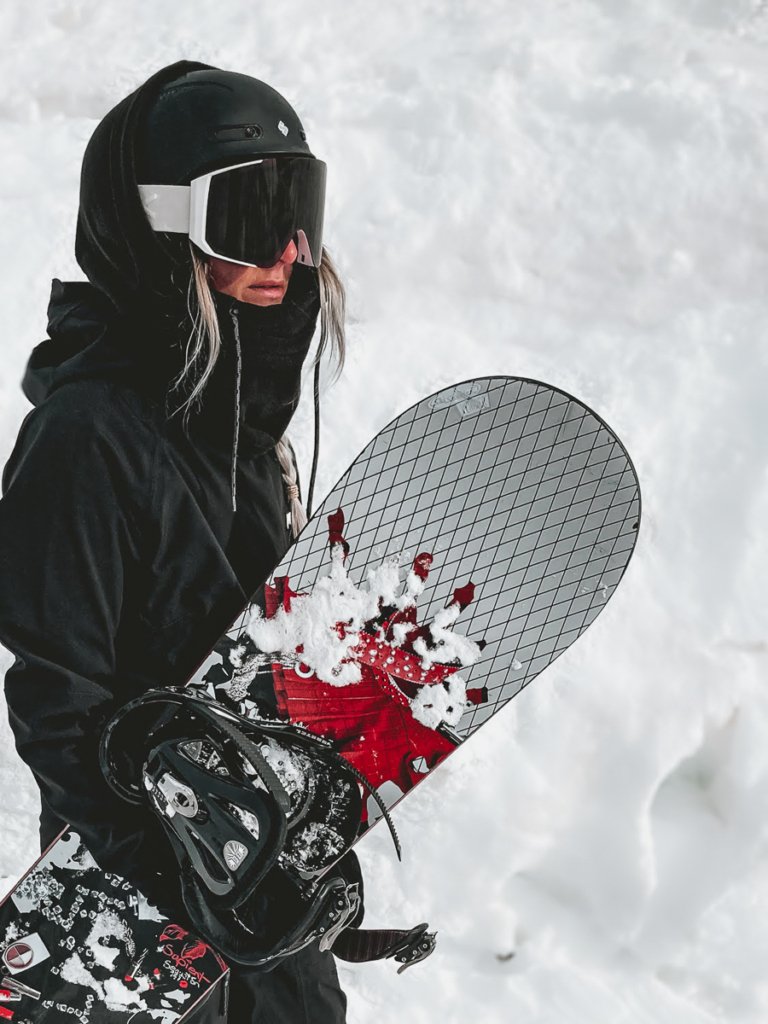
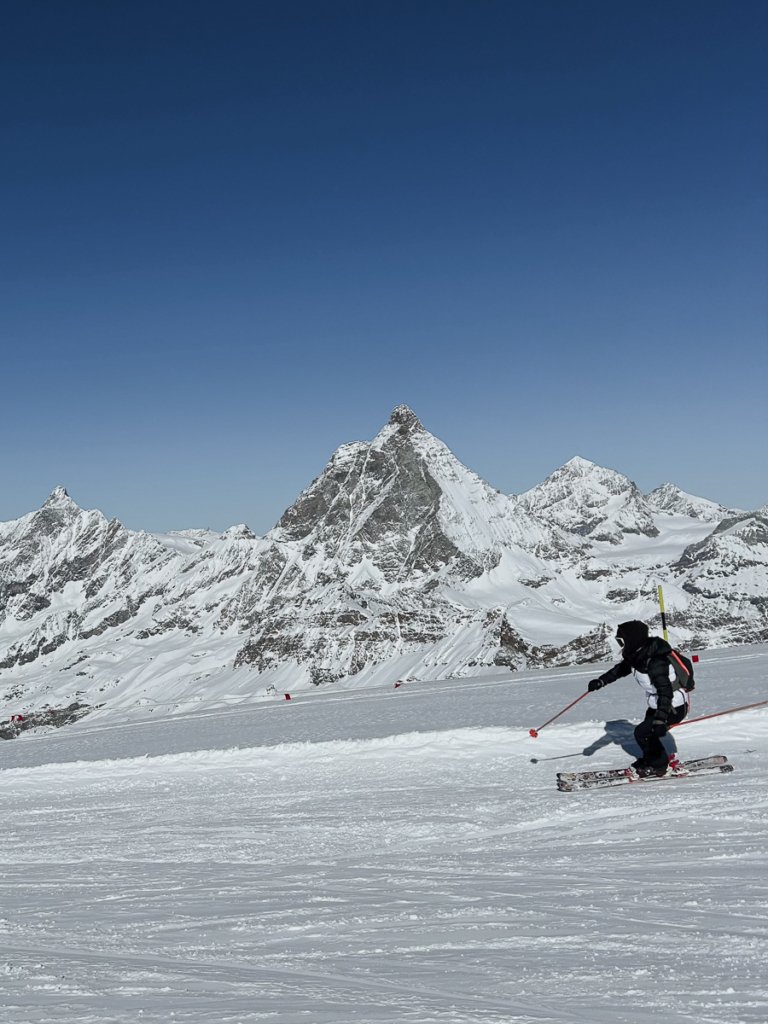
Zermatt is a dream for intermediate skiers and snowboarders. Cruise long top-to-bottom runs from Klein Matterhorn to Valtournenche, Cervinia or Zermatt.
Enjoy the best snow above Trockenesteg and have your first off-piste experience between pistes–with the correct knowledge, equipment and guidance only.
Explore the vast array of red slopes in all three ski areas of Zermatt and the two Italian resorts. The quieter slopes are White Hare, Kelle, and Weisse Perle. Valtournenche is generally quieter than Zermatt and Cervinia.
Zermatt for Expert Skiers & Snowboarders

Zermatt offers only a handful of black slopes for piste skiing, but it compensates for this with a selection of yellow runs when conditions are favourable.
These Itinerary runs are marked off-piste, which means they are marked and avalanche controlled but not pisted. They are an excellent introduction to variable terrain. If you are staying in Winklematten, you can ride Moos 43 all the way home.
Zermatt has incredible off-piste skiing, from a gentle introduction at the side of the piste to ski touring, freeriding, heli-skiing and ski mountaineering.
Given Zermatt’s glacial nature, it’s crucial to never venture off-piste without the right equipment, knowledge, or a qualified local guide. This emphasis on safety ensures that your off-piste experience is thrilling and safe.
Zermatt for Park Skiing & Snowboarding
Zermatt Snowpark is one of the highest in the Alps. It is located on the Teodul Glacier and offers park riding 300 days a year.
In winter, you can access it using the Furggsattel chair. It boasts six creative lines, including a fun slope, a boardercross piste, a beginner line with twelve jumps and twelve boxes, a slopestyle with three rails and three jumps (intermediate to pro), and a rail garden with eight rails.
In summer, the action moves higher to Plateau Rosa, featuring a 300-meter course with fifteen rails, seven boxes, and ten jumps of various sizes.
Additional highlights include beginner, medium, and pro slopestyle lines, a mini shred, and a transition park with a mini-pipe.
Zermatt for Cross Country Skiing
Cross Country Skiers can hop on the twelve-minute train to Täsch to access the Täsch Trail, which offers 10 km of Cross Country Skiing. You can hire equipment from Zermatters Nordic Centre at the Täsch train station. Zermatters also offer beginner Cross Country lessons.
Where is Zermatt?
Zermatt is in southern Switzerland’s Valais (Wallis) canton, right at the foot of the jaw-droppingly gorgeous Matterhorn. Located right on the border of Italy, Zermatt shares the Matterhorn—or Cervino in Italian, with neighbouring Cervina.
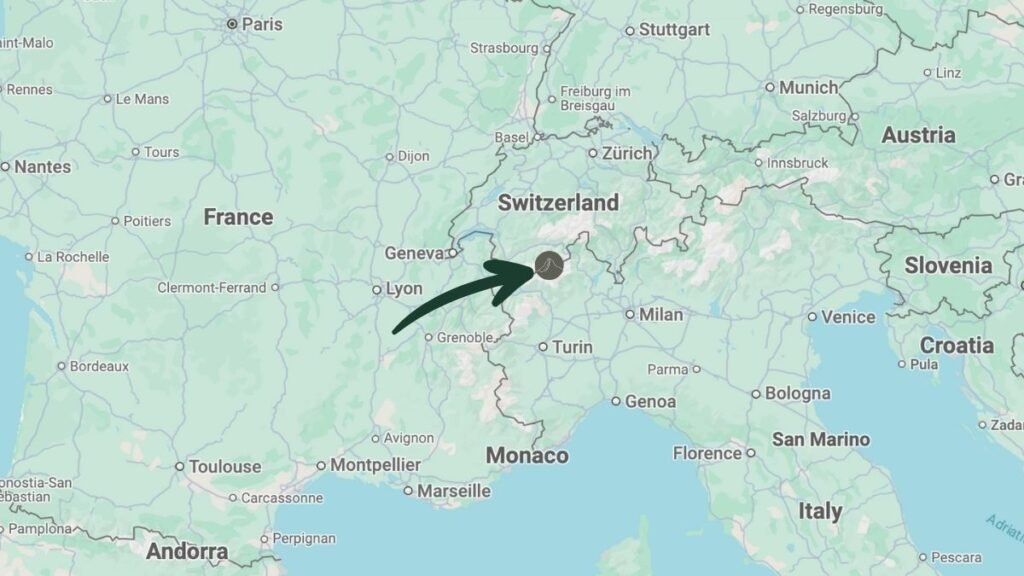
Zermatt
3920
Switzerland
Transfer Time:
- Zurich Airport (ZRH): 3.5–4 hours by train, 3.5 hours by car to Täsch.
- Geneva Airport (GVA): 3.5–4 hours by train, 3 hours by car to Täsch.
- Milan Malpensa Airport (MXP): 4+ hours by train, 3–3.5 hours by car to Täsch.
- Sion Airport (SIR): 1 hour by train, 1 hour by car to Täsch.
For an in-depth guide on getting to Zermatt, check out:
Zermatt Ski Passes

Which ski pass to choose will depend on your budget, length of stay, and ability. The more consecutive days you buy on one pass, the lower the overall ticket price will be. However, be mindful that there are no refunds if you choose not to use the pass.
Booking in advance can also give you the best deal.
For a more flexible pass option, choose the Flex Ski Pass. All ski passes include free use of the electro buses in Zermatt. Those under 16 receive a discount, and children under 9 can ski for free with an appropriate ID.
You can also purchase Ski Pass and Ski Care insurance to cover you in the case of an accident or illness.
Beginners Ski Pass
Complete beginners will want a Beginners Ski Pass, which gives you access to the following:
- Sunnegga funicular
- Sunnegga-Blauherd combi cableway
- Leisee Shuttle
- Eisfluh chairlift
- Findeln chairlift
- Wolli’s Beginner Skiing Park
Although Wolli Park is free to enter, you must purchase a pass for the Sunnegga funicular and Wolli’s Park lift to access it. This lift pass costs CHF 57.00 per day for adults.
Zermatt Ski Pass
You need the Zermatt Ski Pass to access all the slopes between Sunnegga – Rothorn, Gornergrat and Matterhorn Glacier Paradise – Schwartzsee. This pass gives you 200 kilometres of pistes with a wide range of Blue, Red, Black and Yellow slopes. For Adults, this pass starts at CHF 83.00.
The Zermatt Ski Pass has an optional bolt-on to include a daily return journey on the Zermatt shuttle train to Täsch and Randa for CHF 17.00.
International Ski Pass
Added onto the Zermatt Ski Pass for CHF 14.00 per day, the International Ski Pass gives you access to 160 kilometres of pistes in the Italian ski resorts of Breuil-Cervinia and Valtournenche. That’s a total of 360 kilometres of skiable area! Lunch in Italy, anyone?
Matterhorn Alpine Crossing
If your skiing ability isn’t up to tackling the red slopes to access Italy, then don’t worry. You can still lunch in Italia by taking the Matterhorn Alpine Crossing. A return ticket will set you back CHF 148, making it a rather pricey lunch date.
The gondolas will take you from Zermatt to Cervinia and back again, allowing you to stop en route to enjoy restaurants, the views and enter the Matterhorn Glacier Palace.
Skiing & Snowboarding at Sunnegga – Rothorn

The Sunnegga ski area is mainly South to South-West facing, meaning it receives more sunshine than any other slopes. The name Sunnegga translates to Sunny Corner.
Here, you’ll find some of our favourite mountain restaurants: Fluhalp, Chez Vrony, Adler Hitta, Paradise, and Findlerhof. These are all great spots for al fresco dining. Make a reservation at Paradise if you’re looking for one of the best fondue options on the mountain.
Beginner skiers and snowboarders will begin their skiing journey in Wolli’s Park below the Sunnegga lift station. Being the sunniest area means it is often the warmest, which makes those early slow progression phases, more comfortable.
There are linked blue runs from the beginner area to help with your next progression.
Along with blue slopes, the Sunnegga—Rothorn ski area offers red, black, and yellow pistes and off-piste skiing in good conditions for experienced riders or those with a qualified guide.
The yellow pistes are off the back of Rothorn towards Tuftern, from Blauherd to Eja and Hohtälli to Gant. The Hohtälli lift also gives you access to the Gornergrat Ski area.
Snowboarders, there is a long, flat section before the Findeln chair, so you’ll want a little speed to make it without unclipping.
Getting to Sunnegga – Rothorn


Take the Sunnegga funicular train from Vispastrasse in Zermatt to reach the Sunnegga – Rothorn ski area.
The Green Line bus runs in a there-and-back route from the central train station, stopping at all ski lift stations. The Red Line bus runs via Winklematten, stopping near the Snowboat to access the Sunnegga funicular train.
Night Skiing in Zermatt
You can also participate in the Moonlight Descent in the Sunnegga – Rothorn ski area. This is one of my favourite activities in Zermatt.
The Moonlight Descent in Zermatt is a unique ski & snowboard experience under the full moon’s glow. It occurs once a month from December to April, and the starting time is typically around 7 p.m.
Upon arrival at Rothorn, you are treated to an Aperitif before starting your descent. As you glide down the almost deserted slopes, you’ll be surrounded by peaks shrouded in mystery, gleaming under the moonlight. The winter forest adds to the enchantment of the experience.
The Zermatt Bergbahnen piste and rescue service will accompany you during your descent. Upon arrival at CERVO, you’ll be greeted with a mulled wine before sitting down to a traditional Swiss Fondue, where some local live music will entertain you.
Skiing & Snowboarding at Gornergrat
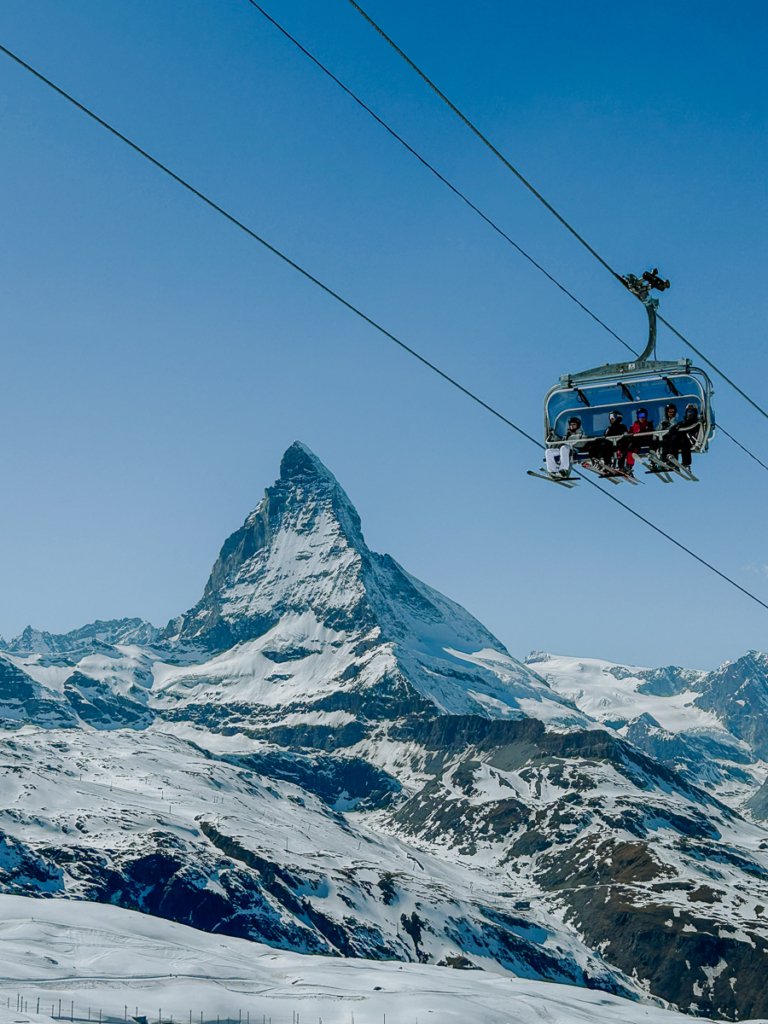
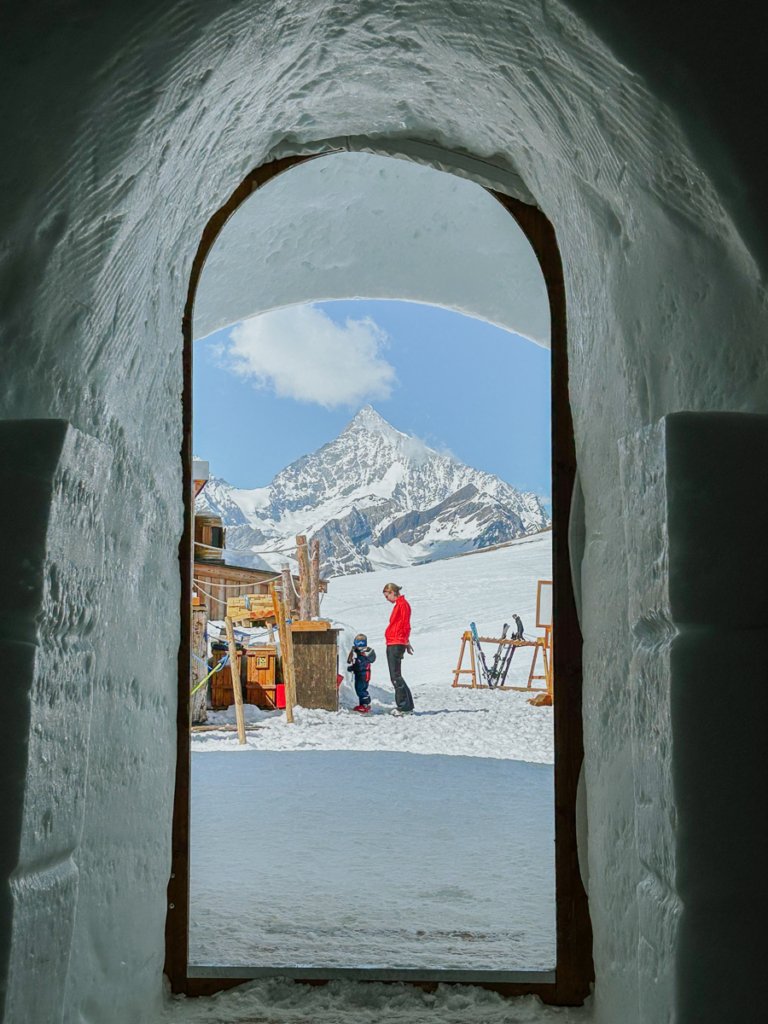
The Gornergrat Ski Area is excellent for all abilities. There are nice, wide, cruisy blues between Gornergrat and Riffelberg and challenging reds that flow back to Zermatt.
In good conditions, Gornergrat is a great place to introduce off-piste skiing or boarding to those with the right expertise, equipment, and guidance. From Schweigmatten, you’ll find a scenic yellow, which is excellent for more confident riders but not as challenging as many long, steep yellow pitches.
It has some fast corners, bumps, and narrow paths, so know your ability before venturing down it. Yellow runs are marked for expert skiers and snowboarders for a reason.
One of our favourite places to stop for a fondue or a quick hot chocolate is the Iglu Dorf on Blue Run 45. The best lunch spot in this area is Alphitta at Riffelalp.
If you’re not up to tackling the red runs, you can take the train from Riffelberg to Riffelalp and walk along the path to the restaurant. They offer great food, amazing views, friendly banter, and often live music.
Snowboarders, the path after the tunnel by the Riffelberg Restaurant is uphill. You will have to unclip to reach the Riffelberg train platform.
Getting to Gornergrat
There are two ways to access Gornergrat from Zermatt village. There’s the Gornergrat Railway, which is opposite the central train station. And there’s the Matterhorn Glacier Paradise cable car near the Hotel Focus – change at Furi for the Riffelberg cable car.
Both the Red and Green Line buses go to these stations. Based on your starting location, check which one you need.
Skiing & Snowboarding at Matterhorn Glacier Paradise – Schwarzsee
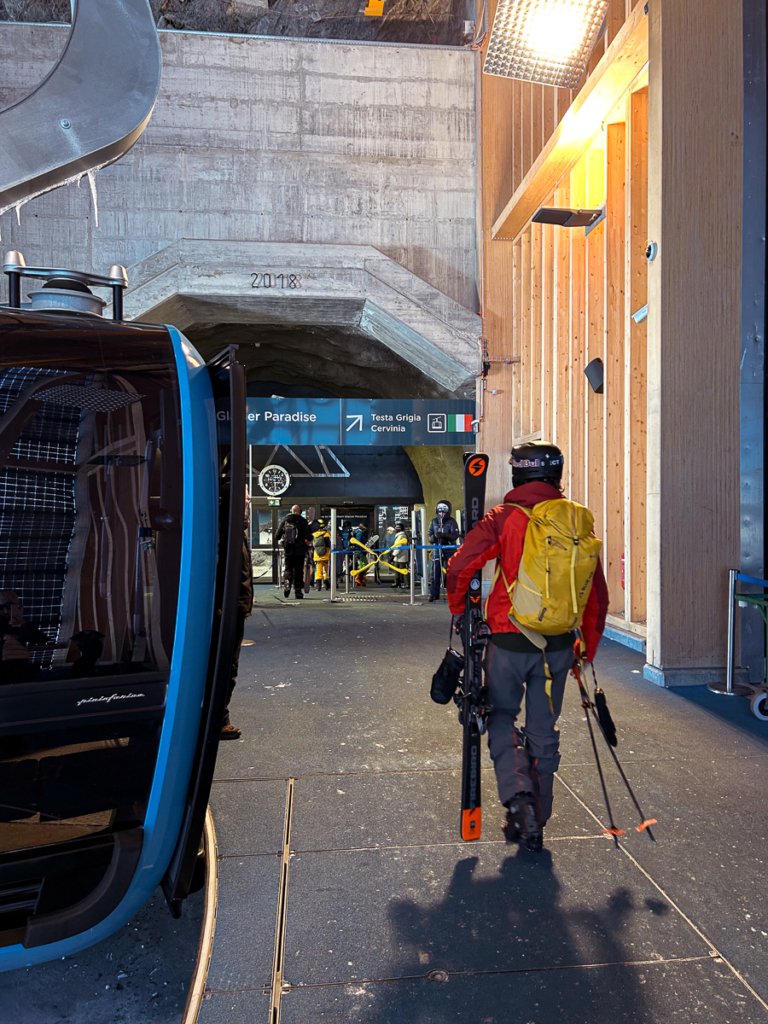
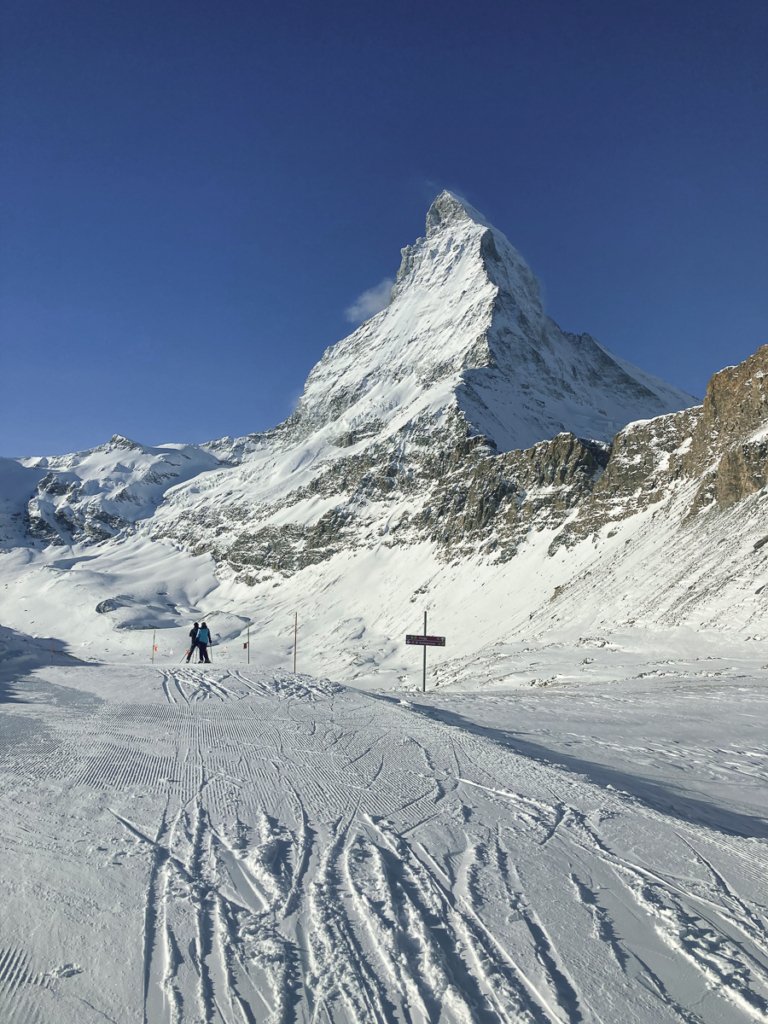
The Matterhorn Glacier Paradise—Schwarzsee ski area is best for intermediate to expert skiers and snowboarders. There are very few blue runs in this region. The pistes are predominantly red, with a few blues, busy steep blacks, and a handful of challenging yellow pistes.
Due to its height, the snow is generally better above Trockenesteg than anywhere else in the resort. The winter snowpark is also located here.
Off-piste riding in this area can be great fun if the conditions are safe, especially for experienced, equipped people with a qualified off-piste guide. However, please take extra care, as the area is glacial and littered with crevasses.
Riders jumping into the off-piste because they see tracks and deem it “safe” often fall into crevasses and have to be rescued by Air Zermatt. Don’t be that guy. Only the lucky ones survive.
With an international Ski Pass, you can also access the slopes of Cervinia and Valtournenche from Matterhorn Glacier Paradise. While the skiing into Italy is primarily red runs, you can pay extra for the Matterhorn Alpine Crossing to access the blue area at Plan Maison.
Or not ski at all and take in those rays while dining al fresco. Cervinia is a south- to southwest-facing resort that receives a lot of sunshine.
Our favourite restaurants in the Matterhorn Glacier Paradise – Schwarzsee area are Stafelalp, Marmo and Zum See. In Italy, book at Chalet Etoile or head to Cervinia following Blue Run 5 for Pizza and Aperol at Pizzeria La Grotta.
For a unique experience, watch the sun disappear behind the Alps from Rifugio Teodulo with a sharing board and glass of wine.
Snowboarders, access to Theodulgletscher 71 has an uphill, with a little bit of speed, you should make it without unclipping.
The final section of Blatten 50 slope, below Hennu Stall, is also a long flat. Congrats if you make it to the bridge without unclipping. Skiers, do your snowboarding buddies a favour and give them a tow.
Getting to Matterhorn Glacier Paradise – Schwarzsee
To reach the Matterhorn Glacier Paradise—Schwarzsee ski area, take the Matterhorn Glacier Paradise cable car from Zermatt. The Red and Green Line buses take you close to the lift station. Be sure to know your starting point when choosing the appropriate bus.
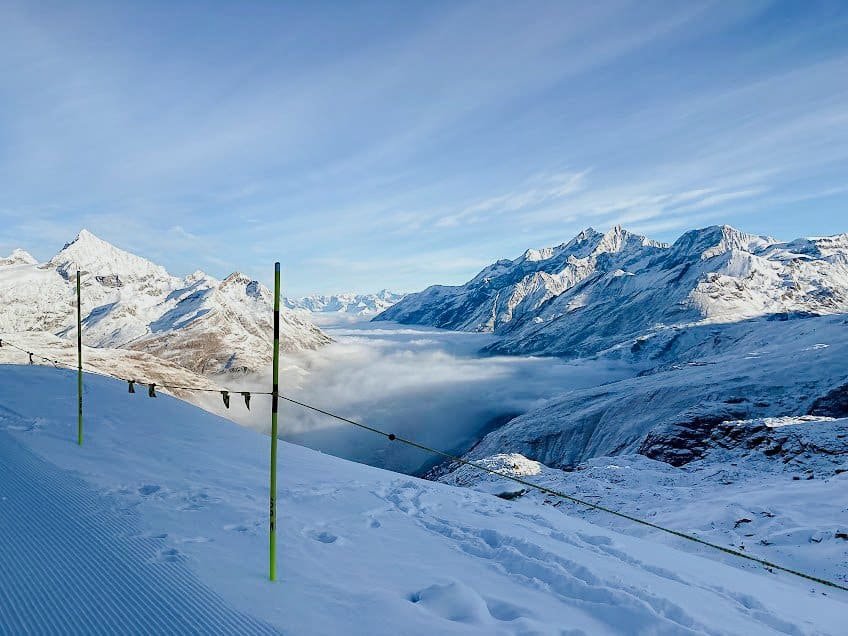
Zermatt Skiing & Snowboarding Map
Here is an interactive map link to show where all of the ski lift stations are located in Zermatt.
Zermatt Piste Map
Here is an Interactive Map Link to the Zermatt Piste Map. This link lets you view the live piste map or download a PDF version.
Best Zermatt Skiing & Snowboarding Apps
Live Lift Status – Skiguide Zermatt / NEW MATTERHORN APP – Apple / Android
This app gives you real-time information on open and closed pistes and a handy interactive piste map.
Best Weather App – MeteoSwiss – Apple / Android
Keeping track of the weather can be difficult in mountain regions, but MeteoSwiss is often the most reliable.
Best Time to Ski & Snowboard in Switzerland
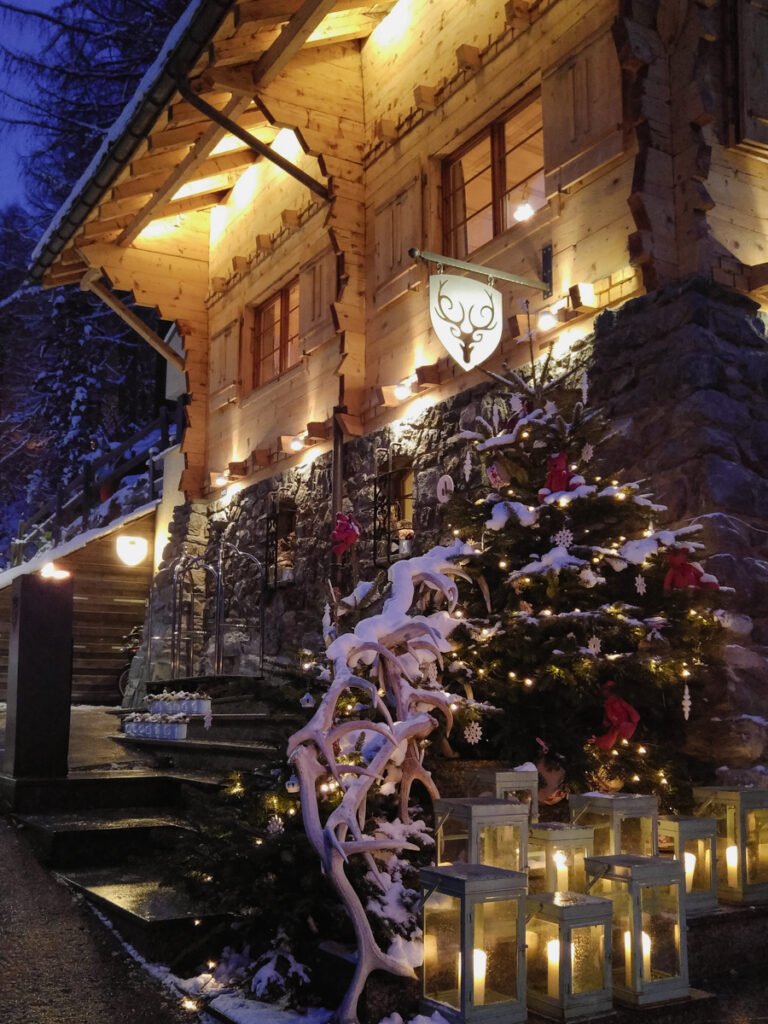
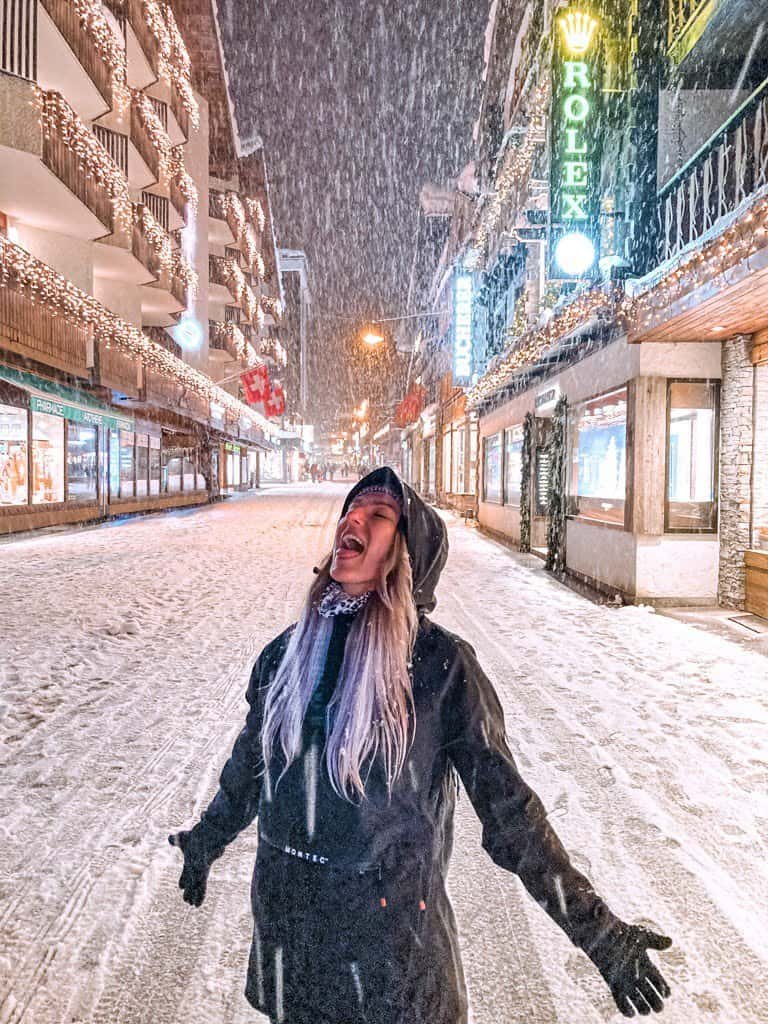
The busiest and most expensive times to ski and snowboard in Switzerland are during school holidays, such as Christmas and New Year, and the February half-term. If you’re not tied to school holidays, I would avoid February!
If you plan to ski during the festive period, you’ll have to accept that it will be busy, but it will undoubtedly be a magical experience.
January is the best time to ski in Switzerland for the best snow conditions and fewer crowds. The downside with this time of year is that it is also the coldest, but it can pay off if you’re happy to wrap up warm.
Consider skiing in Switzerland in March-April, when temperatures are warmer, the snow is slushy, and the days are longer. If possible, avoid the Easter school holidays.
If you’re a beginner skier or snowboarder, visit Zermatt during the quieter months to avoid chaotic pistes.
Ski & Snowboard Rentals, Lessons & Guiding

Zermatt has a cracking selection of rental shops to suit every skier and snowboarder, from complete newbies to seasoned pros. You’ll find big names like Intersport, known for its top-notch gear and expert staff who’ll kit you out with everything from skis to helmets.
Local favourites like Glacier Sport and Julen Sport offer personalised fittings and high-end equipment that’ll have you gliding down the slopes like an Olympian (well, one can hope).
Many of these shops are dotted conveniently around the village, some like Dorsaz Sport (Intersport) even right at the base of the lifts—because who wants to lug skis halfway across town?
Zermatt’s ski schools and guiding services are nothing short of top-tier, from private lessons where you’ll have instructors’ undivided attention to fun group sessions that are perfect for making new mates on the slopes.
The instructors are absolute legends—experienced, multilingual, and ready to fine-tune your technique or guide you through Zermatt’s thrilling off-piste terrain (if you’re feeling brave!).
If you’re a total beginner, don’t sweat it—they’ll get you from “Bambi on ice” to a confident rider in no time.
Best Things to Do in Zermatt
Although skiing is the number one activity in Zermatt during the winter months, there is also a wide range of other snow and non-snow activities. Why not try snowboarding or tabogganing?
Have you ever wanted to jump off a mountain and soar back down to the ground? Paragliding is another popular activity in Switzerland.
If all that adrenaline is just a bit much, you can enjoy some great spa packages, walking tours, dining experiences, and shopping adventures instead.
Private Ski or Snowboard Lesson
For first-timers, people who want to improve and nervous skiers, we always advise hiring a ski instructor. It can be the difference between loving or hating this activity and the speed at which you improve.
With customised lessons, private or group instruction, and a team that speaks Russian, English, Italian, French, or Spanish, this is our go-to for ski lessons in Zermatt.
Paragliding

One of the most exciting experiences in Zermatt is Paragliding above the village, with the stunning backdrop of the Matterhorn. I will never forget this experience.
Hire an experienced guide to take care of your safety on a tandem flight in one of the most magical locations in the world.
Zermatt Village Walking Tour
Journey back in time on this walking tour of the beautiful Zermatt village. Stroll down Hinterdorfstrasse and learn about the history of these well-preserved mountain huts built between the 16th and 18th centuries.
Learn about the first ascent of the Matterhorn and how Zermatt became what it is today.
For more activities, check out:
Skiing & Snowboarding in Zermatt FAQs
Let’s dive into some frequently asked questions about skiing and snowboarding in Zermatt.
How Difficult is the Skiing & Snowboarding in Zermatt?
Zermatt is a slightly more difficult resort to ski or snowboard, especially for beginners. With a small beginner area and limited blue runs, it is not always ideal for first-time skiers and snowboarders.
While skiing and snowboarding can be challenging for beginners, Zermatt is ideal if you learn quickly and are eager to tackle those red pistes. It is the ultimate intermediate-level resort, with great progression options for more advanced skiing and snowboarding.
Is Snowboarding Good in Zermatt?

Snowboarding is excellent in Zermatt, especially for intermediate to expert riders. With 360km of pistes and so much off-piste terrain, there’s plenty here to explore.
During winter, you’ll find the snowpark at Trockenesteg and in summer at Plateau Rosa, making it a fantastic year-round destination for snowboarders who like to ride park. With varied rails and jumps, it’s perfect for all levels.
Is it Expensive to Ski in Zermatt?
With 360 kilometres of slopes, you certainly get bang for your buck in Zermatt. But what creeps up the budget is accommodation, transport and dining costs. Switzerland as a whole is known as one of the more expensive skiing destinations, but that doesn’t mean you can’t do it affordably.
With careful planning and booking, there are many ways to make a ski trip to Zermatt more affordable.
Can Beginners Ski in Zermatt?
Yes, beginners can ski in Zermatt. The beginner skiing area is called Wolli’s Park, locally known as “The Wolli Park,” and is dedicated to all first-timers. The only downside to beginner skiing in Zermatt is that the progression is straight to blue runs from the beginner skiing area.
Zermatt does not have any green slopes. However, this should not deter you if you feel confident enough to tackle those relatively easy blues.
Once you have mastered your plough parallel and are confident on blue runs, there’s a whole world of beginner—to intermediate skiing in Zermatt to conquer.
Is Zermatt Ski Resort Crowded?
Zermatt ski resort can get crowded during peak weeks, which fall on school holidays in December and February. Outside of these times, the slopes can be quiet on weekdays. Weekends can also get quite busy due to local tourism.
January is the quietest time to visit Zermatt during winter, and an excellent opportunity to lap those well-groomed pistes. A week day in January or March is often when you’ll find the pistes less crowded.
Wrapping Up Skiing & Snowboarding In Zermatt
If you’re looking for a Christmas escape, your first venture into snowsports, great live music and après ski, a challenging adventure or a good combination of skiing and dining, Zermatt is for you.
With stunning views, extensive slopes, a charming alpine village, and the opportunity to venture into two Italian ski resorts, it’s no wonder Zermatt is a bucket list skiing destination.
The resort’s blend of tradition and modernity and its commitment to sustainability make it an exceptional choice for a ski or snowboard trip.
So, if you haven’t experienced the magic of Zermatt’s slopes yet, it’s time to plan your next winter adventure in this picturesque Swiss resort. See you on the slopes!